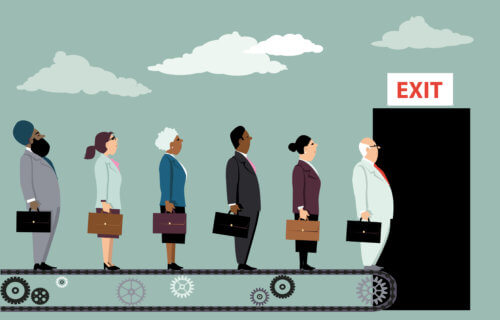LONDON — Many workers would probably love to find career that they stick with their entire lives, but a new survey finds plenty of people are looking for a new line of work by their 30s! In fact, the average worker is most likely to change their career direction by the age of 31.
For many, this age marks a decade in the workplace, suggesting that today’s employee gets the “10-year career itch” before pivoting to a new vocation. The poll, of 5,000 employed adults, found 26 percent are considering a career change in the not-too-distant future, while 44 percent have already made the leap to something completely new.
One in three made a change because they wanted to pursue a career which offered better opportunities to increase their earnings, while 32 percent longed for a role that they felt more passionate about.
For 19 percent of career changers, however, the key motivation was a better work-life balance, with 15 percent taking the opportunity to change things up after being laid off. For those who have changed or are considering a career move, healthcare, education, and IT have emerged as the most popular industries workers are considering.
“Changing career can be daunting and feelings of uncertainty are natural when faced with such a major decision,” says Doug Rode, U.K. & Ireland managing director at global recruitment specialist Michael Page, which commissioned the research, in a statement.
“But job hunters should be empowered by our findings, which show 68 percent of people who have made the switch ‘never looked back.’ Whatever is driving you to seek change, be that the calling to pursue a personal passion or getting back to work following a redundancy, it is important to take the time to properly research and plan out your next steps,” Rode continues.
“While this data shows 31 is the national average age to change career, everyone is different. You shouldn’t feel under pressure to make decisions about the future of your career until you feel the time is right. Assess your skills, your drivers and your ambition, and then find a career to match – there are plenty of opportunities in the market for workers who are open to taking them.”

The research, conducted by OnePoll, also found 54 percent of those surveyed would either consider or already have taken on a temporary role to support their switching process. Four in 10 (41%) see an interim role as a chance to have greater flexibility and 27 percent believe that temp or contract opportunities can build broad experience in different industries.
For those who have made a successful career switch, the most popular route to success is through online courses (25%), while many also went back to school (14%). Of those who gained further training, 42 percent paid for their own studies, while 27 percent received government funding.
A further 21 percent had their training paid for by their current employer. Another 13 percent says the skills and experiences they had already developed were transferable to their new sector or job function.
For workers still considering a switch, the average time frame for planning a career move is 13 months — showing just how seriously today’s workers are taking their future career choices. For those who decided to make the move, it then took an average of 10 months to land a job.
Among those who have considered switching careers, this critical thinking time has led some to cancel their plans — as 27 percent did not feel financially secure enough to potentially reduce their earnings as a result. A significant hurdle for 23 percent was a lack of confidence, and 20 percent were unsure if they already had the skills to facilitate the move.
Another 15 percent were concerned about being older than their co-workers in a new field if they were to make a career change. Looking at workplace trends more broadly, 31 percent of workers would consider returning to a role at a previous employer, while 13 percent of workers have already done so.

These “boomerang workers” have done so in order to work closer to home (12%), while nine percent felt like going back to a past employer was a “safe choice.”
“Today’s workers have more agency and confidence than ever before, and our new research shows how this is reflected in their career choices. The previous blueprint of a linear career path has been largely consigned to history,” Rode says.
“Today’s workers are prioritizing their own fulfilment at work and are more open than ever to pivoting if something feels more aligned to their values. It is heartening to see that, even in the current economic climate, swathes of workers are committed to finding their dream career.”
“Post-pandemic, we have created a unique landscape where workers have access to so many different opportunities. Today, it’s normal to hop between jobs until you land on the right one – it’s easier than ever to move between temporary and permanent roles in a bid to try out a new function or industry. Opportunity is out there, regardless of what age you are – there’s always time to change up your path and find a career that puts a spring in your step each day.”
South West News Service writer Oliver Lewis contributed to this report.
You might also be interested in:
- Great (Pet) Resignation: 6 in 10 have quit job because their office wasn’t pet-friendly!
- Quitting already? Survey reveals 2 in 3 Gen Z workers will leave their jobs within one year
- Best Careers For 2023: These Are The Top 7 Jobs In America, According To Experts

